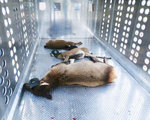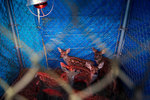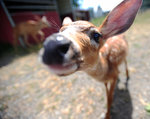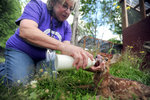



‘Habituated:’ Officials Vow to Return For 11 Remaining Deer Deemed Too Tame to Be Wild After Tip From Former Volunteer
For the past eight years, Claudia and David Supensky have spent nearly all of their waking hours patiently nursing injured and ill wildlife back to health in preparation for eventual return to the wild.
So when state wildlife officials showed up unannounced at their home-based For Heaven’s Sake Wildlife Rescue and Rehabilitation Center in Rochester last Thursday and began shooting fawn deer with tranquilizer darts, the couple was understandably distraught.
Three of those fawns and one elk calf were euthanized by the Washington Department of Fish and Wildlife last week after they were deemed to be too friendly to humans, and the future of the remaining 11 fawns at the facility currently hangs in the balance.
“It just broke my heart,” said Claudia Supensky, describing her reaction to seeing a photo on Facebook of the young ungulates unconscious in the back of a WDFW truck on their way to be killed. “It was the most horrible feeling in the world because we had no control.”
According to the WDFW, a former volunteer at For Heaven’s Sake submitted a tip to the department that the deer and elk being cared for at the facility had been exposed to too much human contact, which caused them to become “habituated,” or “imprinted,” to the presence of people. State law dictates that rescued wildlife that become too accustomed to humans can be used for educational purposes but are not allowed to be released back into the wild.
“The department licenses wildlife rehabilitators to prepare sick, injured and orphaned animals for release back into the wild, but those animals have virtually no chance of surviving if they become habituated to humans,” said Eric Gardner, head of the WDFW Wildlife Program, in a press release. Gardner added that habituated wildlife can also be a danger to the public, and cited an instance in Davenport last month where two people were gored by a habituated buck deer.
However, the Supenskys wholeheartedly refute the claims of the former volunteer and the WDFW. On Monday, Claudia Supensky pointed out that over the past eight years, For Heaven’s Sake has rehabilitated close to 200 deer that were successfully released to the wild. She said they’ve never changed their practices over the years and they’ve also never failed to revert a deer back to its wild nature.
Supensky also took exception with a quote attributed to her by other news outlets that was widely publicized last week that appeared to read as an admission of wrongdoing.
“It said that I said the fawns are too friendly to be released and it’s completely the opposite,” said Supensky. “I said, ‘Fish and Wildlife said they are too friendly to be released,’ and I know that they’re not.’”
Supensky explained that she, her husband and their assorted volunteers follow the same protocol with each young ungulate that’s brought to the facility, taking care to limit the animals’ exposure to up-close human interaction. However, when young fawns and calves lose their mothers, they require milk and thus must be bottle-fed by humans for a time once they arrive at the rescue center. Supensky says that once the animals learn what a bottle is, workers begin feeding them through a bottle rack in a barn that provides a visual barrier between the workers and the animals in order to begin the separation process.
Once the deer are weaned, Supensky says they are let out into the back acreage at the rehabilitation center where in the past they were allowed to overwinter and “wild up” before being released into the real wild in the springtime.
“It takes a while for them to wild up and be ready to release after they’ve been weaned,” said Supensky, who noted that most of the deer in her care are, or were, between three and four months old. Despite the young age of the deer fawns, Supensky says that the WDFW was adamant the deer should have been released by the end of September.
“We’ve never done that. Our protocol is to put them on our back acreage where they never see people and they can learn to be wild over the winter months,” explained Supensky. “Then we have a real difficult time rounding them up in the spring, but it’s worth it because we can release them and they can survive in the wild.”
Gardner said that Oregon state law stipulates a specific date for rescued deer to be released but noted that Washington has no such law.
“This practice is a little unusual,” said Gardner, who does not believe that research backs up the Suspenskys’ claims that overwintering deer better prepares them for the wild. But, he added, “It was not a violation of Washington state law by any means.”
This year though, based on the word of what Suspensky calls a disgruntled and misled former volunteer, the WDFW decided things weren’t up to snuff. A regularly scheduled inspection in August found no problems at the facility, but a follow-up inspection in late September, triggered by that tip from the former volunteer, is said to have revealed “significant problems with human habituation,” according to a WDFW press release.
Supsenky claims that the WDFW already had their minds made up when they showed up for additional inspections, and she fears that despite her best efforts the remaining fawns are likely doomed.
“When this had happened they were still taking bottles and they’re not going to look like they’re very wild when they’re on a bottle,” said Supensky, who noted that the deer had been living in the enclosed woods on the couple’s property for about two weeks before the WDFW showed up with dart guns last Thursday.
“The deer didn’t even come out of the woods to greet us and her statement to us was, ‘It doesn’t matter if I see them I already know they are habituated,’” said Supensky, who was quoting Patricia Thompson, the WDFW on-site inspector.
Supensky claims that Thompson lured a calf elk and a tiny fawn with the help of an apple during Thursday’s roundup effort, but noted that the rest of the ungulates fled into the woodline when wildlife officers approached.
“They were unable to catch them because they are not habituated,” said Supensky.
That’s when WDFW wildlife officers began hunting the deer on the enclosed property using dart guns to capture the fleeing animals.
“They took them away and said they would be back within the next few days to take the rest,” said Supensky on Monday as she nervously waited for the second round of the raid to commence. “The fact that they’re not giving us these extra months. I just don’t understand. She’d rather kill them than give them these extra months.”
A press release sent out by the WDFW on Monday was titled, “WDFW evaluates deer at rescue facility after euthanizing four habituated animals,” but Gardner admitted that no additional visits or actions have been made in regard to the facility since Thursday’s raid. He also claimed that there “are no solid plans” for a return visit.
In a conversation with The Chronicle on Monday, Gardner said he hopes to be able to “engage in a dialogue” with the Supenskys in an effort to find a way forward that does not require the euthanization of the remaining 11 deer. With a tinge of irony, he noted that Washington State University is interested in taking in six or seven friendly female fawns for use in a study. Gardner noted that any male fawns would need to exhibit strong wild instinct in order to warrant consideration for release.
Gardner did not sound optimistic about the chance that any of the deer would wind up released to the wild, but noted, “We’re at least hopeful that some of them will find placement with WSU.”
Gardner also expressed skepticism about Supensky’s assertion that the standard operating procedure for deer and elk has never changed since the facility opened in 2010.
“I would not say that they’ve been out of compliance, nor would I say that the protocol has changed. What I would say is that that’s not the standards and it wasn’t expected. I guess they didn’t communicate their plan very well,” said Gardner. “It took the inside information to essentially let us know that there was a problem there.”
Supensky says she doesn’t understand how she could have been more upfront. She has always opened her doors to regular state inspections and even brings in her own veterinarian once a week to check on the health of the animals under her care.
Jaclyn Fraser has volunteered as the veterinarian at For Heaven’s Sake since last February. She says that the Supenskys are always quick to treat animals with illnesses or injuries, and the facility is kept clean with daily chores.
“All the animals are well taken care of and everyone works hard around the clock. Claudia and her husband live on the property and I know she is up until 1 or 2 o’clock in the morning sometimes taking care of the animals,” said Faser. “From my perspective I feel like all of the animals are in a good place to be rehabilitated and released. I feel that the work they do is really good work.”
Claudia Supensky noted that when her facility was first red-flagged by the WDFW in September she was told that a wildlife biologist would be summoned to make a determination on the condition of the deer. She says that assessment never happened prior to the WDFW showing up to confiscate the deer, and she’s worried that laws may have been broken during the WDFW’s removal efforts.
Gardner quickly shot down that idea.
“I know Claudia is concerned about a due process law but it has more to do with the permits than the animals themselves,” said Gardner, who speculated that too many volunteers were allowed to interact with the deer. “The deer don’t belong to the rehab. They belong to the state of Washington.”
In a press release, Gardner described the Supenskys as caring people who work hard on behalf of the animals placed in their care and confirmed that this is the first time the couple has been in violation of rules habituating wildlife at their facility. That same press release noted that For Heaven’s Sake has already been stripped of their license to rescue and rehabilitate ungulates in the future.
Supensky says she feels betrayed by the state and doesn’t understand why the WDFW would take such draconian actions following the first complaint their facility has received since it was opened eight years ago.
“This has been so, so upsetting. I can’t even begin to describe how upsetting it’s been,” said Supensky. “We’ve never, ever, had anyone complain to Fish and Wildlife before in all the years that we’ve done this. It’s been a shock to us.”
Supensky claims that the former volunteer who reported For Heaven’s Sake to authorities was out to get them and staged photographs of animals being bottle-fed in order to drum up concern. Supensky said the woman even tried to recruit other volunteers to join her cause.
“Why Fish and Wildlife would take the word of a 21-year-old campaigner over ours after all these years is really disappointing and hurtful,” she said.
Suspensky says that they typically bottle feed fawns and calves for about four months, or until their spots disappear, which is typically less time than mothers nurse their babies in the wild. She added that she obtained a photograph last week that showed an elk cow still nursing its calf in the wild.
“So we don’t feel like we’re doing anything wrong by feeding the bottles that long,” said Supensky. “There’s a lot facets to this whole thing but the deer are the one who are paying the price for it, and that’s not fair.”
With so much up in the air right now, Supensky says she is hoping that public outcry will help to save the deer that are still hiding in her backwoods. She envisions a change of heart at the WDFW or possibly an injunction by the governor as she waits for the WDFW to make its next move.
“We’ve had these fawns since they were little babies and we were doing right just like we always have, without any complaints, without any incidents, and then they come here and they take our deer,” said Supensky. “To me, I don’t care if they take my license. I’m focused on saving these deer who can still be released. And if I never take in another deer, it will be worth it if I can save these.”